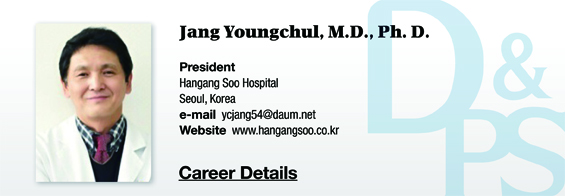▶ Previous Artlcle : #13-1. Non-allograft Biological Dressing Materials
Porcine skin, Xenograft skin
Porcine skin has a structure similar to human skin and with introduction of various processing methods, its application has expanded with many types of dressing materials. These products reduces antigenicity and are processed though cryopreservation or irradiation to lengthen the time of adhesion with the wound surface. The key benefit is the affordability and steady supply. Just as the human allograft, it also locks in moisture and prevents infection. It promotes epithelization of the wound, however, unlike allograft, it does not allow ingrowth of blood vessels which limits its use to only temporary wound coverage in second degree burns and donor sites.
[Advertisement] A-One LITE(Facial Diagnosys System) – Manufacturer: BOMTECH(www.bomtech.net)
Bioengineered substitutes
The most prominent example of bioengineered substitute is Biobrane®. Biobrane® was produced three decades ago by applying silicon to nylon mesh and chemically combining collagen. Just as other biological dressing materials, it also prevents evaporative moisture loss and infection. The collagen binds to the nylon mesh, promoting ingrowth of fibroblasts in the wound bed and the collagen fibers released from fibroblasts adhere firmly to the nylon mesh, providing better protection of the wound. However, it is susceptible to infection and should be cautiously applied to infected wounds. Daily dressing is necessary to prevent exudate as collection of exudate within Biobrane prevents adhesion to the wound surface.
Bioengineered synthetic skin substitutes include Trancyte® and Dermagraft®. Trancyte® was produced from attaching neonatal human fibroblast, porcine collagen and silicone layer to a nylon mesh. Dermagraft® consists of neonatal human fibroblasts implanted in polylactin mesh. It is used in second degree burn care or as temporary coverage of wound after crust removal or to help autograft survival after extensive debridement.
SUPRATHEL® consists of absorbable polymer (absorbable suture material) which is biodegradable when in contact with the wound to promote ingrowth of blood vessels and collagenesis. It lowers the pH level of the would site to inhibit bacterial proliferation.
SUPRAHEL® serves as an effective protective barrier that prevents infiltration of external bacteria while allowing permeation of oxygen and water vapors.
Advantages of porcine skin are shown in <Figure 4, 5>.
Clinical case of SUPRAHEL® is shown in <Fig 6>

Figure 4. Actions of porcine skin

Figure 5. Advantages of porcine skin

Figure 6. Case of SUPRATHEL treatment.
-To be continued-
▶ Next Artlcle : #14-1. Surgical Wound Coverage





















